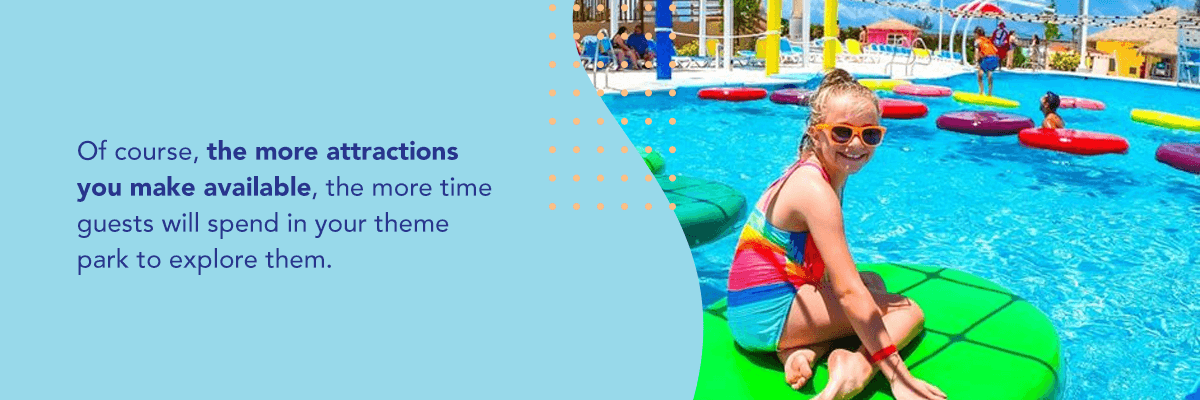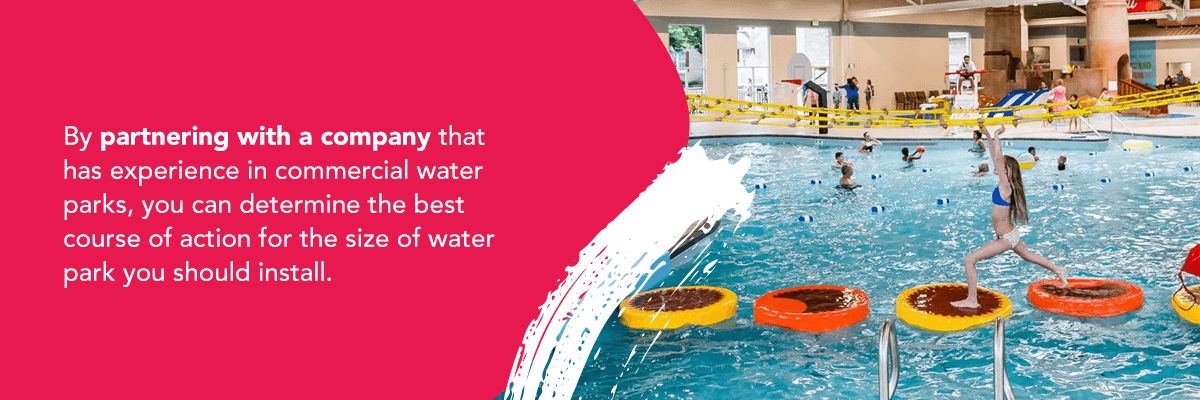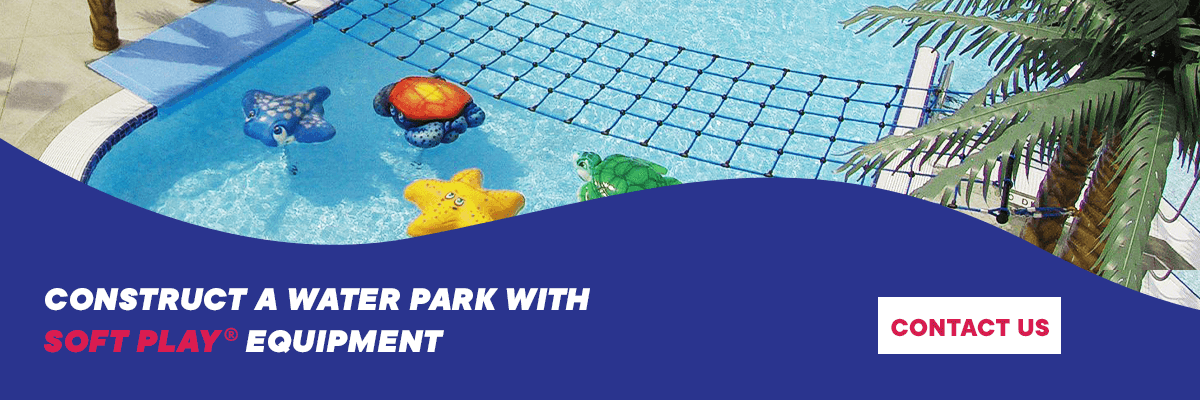Top Benefits of Adding a Water Park to Your Amusement Park

Top Benefits of Adding a Water Park to Your Amusement Park
There’s nothing like spending a few hours at a water park on a hot summer’s day. Between floating down the lazy river and zooming down water slides, kids, teens and adults alike can easily have a memorable time at a water park. This experience becomes even better when water park guests can also enjoy amusement park rides — all in the same location.
As an amusement park owner, incorporating a water park into your existing ride layout lets you enjoy a host of benefits, including more profit, increased guest retention and other perks. Doing so requires you to make a few considerations beforehand. Learn more about starting a water park!
Read the full article or jump to a specific section:
- 10 Advantages of Adding a Water Park to an Amusement Park
- Questions to Ask Before Adding a Water Park
- What to Consider When You Start Building a Water Park
- Construct a Water Park With Soft Play® Equipment
10 Advantages of Adding a Water Park to an Amusement Park
Water parks are truly the ideal addition to amusement parks. A water park will fit perfectly on your property, complementing current rides while bringing numerous advantages to the table.
Here are 10 water park benefits you — and subsequently your guests — can enjoy:
1. Takes up Little Space
In most cases, water parks don’t have to span more than a few acres for them to be enjoyable. Unless you’d like to add several kinds of pools, water slides and rides, you can often find a way to concentrate your addition to whatever space you currently have available. A small water park can be an effective solution to give your patrons a new experience without obtaining more land.
2. Grants More Affordability Than Installing Standard Rides
How much does it cost to build a water park? The total number will depend on various factors, such as the water park’s intended location, which attractions you want to include and who installs it. Still, water park construction often costs less than what you’d pay to build more theme park rides.

A standard water park with the most common attractions may cost around a few million dollars to build. On the other hand, a single amusement park ride, depending on its features and scale, can run you just as much. If you budget it correctly, constructing a water park can be the more affordable option.
3. Gives Guests More Options
For some guests, visiting amusement parks is a weekly activity. Like anything, riding the same rides over and over again may become pretty dull. When you construct a water park, you have an opportunity to give your visitors something new. If they’d like to spend a little time in the pool after riding a few rollercoasters, they can — and they can enjoy their stay more.
4. Draws Attention on Hot Summer Days
While theme parks are popular in the summer, not many people enjoy traversing around one on a particularly hot summer’s day. A theme park that also boasts a water park is a top attraction when it’s sweltering outside.

If guests can take a few trips down a water slide after checking out your amusement park’s standard rides, they’ll be more likely to visit even when the weather is warmer.
5. Encourages Guests to Come Back
A significant benefit of adding a water park to your amusement park is a potential attendance boost. A combination amusement park and water park caters to a wide audience, enticing more guests to return time and time again.
If guests don’t have a chance to explore some of your rides on their first visit, they’ll want to come back to experience them. Even when patrons spend the entire day at your amusement park, the number of different attractions will likely encourage them to stop by in the future, possibly with their friends and family in tow.
6. Increases Stay Time
Of course, the more attractions you make available, the more time guests will spend in your theme park to explore them. As a result, guests have more time to spend money at gift shops, food stands and other areas of your amusement park. If you offer passes that allow visitors the chance to skip lines, you could potentially see an increase in sales because many visitors will need to cut down on their time in line to see everything.

7. Attracts New Guests
Adding a water park will help you attract new patrons to your amusement park. Those who don’t particularly enjoy theme park rides but like to spend time at water parks will now be inclined to explore your attractions. In other words, constructing a water park opens up your property to a whole new sector of visitors. A pool appeals to guests who aren’t fans of thrill rides, and splash pads entice families with young kids.
8. Sets Your Amusement Park Apart
Based on your theme park’s location, it may be one of a few popular amusement parks in the area. Unless you offer patrons something different, they’ll likely view your facility just like any other theme park.
A water park can be the deciding factor when guests are deciding where to visit for the day. If your property can give them the best of both worlds in terms of an amusement park and water park rides, you’ll likely win them over more often than not.
9. Provides an Economic Boost
Creating a water park provides employment opportunities for dozens of people in your community. Since your theme park staff will be focused on that part of your property, you’ll need to hire new employees — like maintenance workers, lifeguards and administrative staff — to run your water park. As a result, you can positively impact your local economy.

10. Offers an Opportunity for Conservation
This point may seem counterintuitive, but you have an opportunity to offer sustainable amenities and entertainment for your guests. Strategies like filtering and recycling water, choosing high-quality equipment that won’t degrade quickly and partnering with eco-conscious food service vendors will only improve your reputation in the eyes of the consumer.
These days, more and more people care about sustainable initiatives, with 62% of consumers in travel and tourism industries valuing sustainability. Customers want to know their money will help support environmental causes. By prioritizing and advertising conservation in your water park build, you can improve your relationships with existing guests and build connections with new ones.
Questions to Ask Before Adding a Water Park
Before you start your construction plans, it’s essential to make a few considerations — building a water park is no small feat. Fortunately, preparing can make a significant difference. As you and your team talk through the idea of adding a water park to your theme park, addressing certain questions can help you narrow down your plans and goals.
Below are some questions to consider as you plan out your water park addition.
Do You Need Permits or Certification to Build a Water Park?
In some ways, building a water park differs from building a theme park, simply due to the kinds of structures you need to add. For instance, your local municipality may require you to obtain a permit before you construct any pools. Therefore, you should make sure you have the proper licensing in your back pocket before you proceed.
Do You Have Enough Acreage to Build a Water Park?
Of course, you need land to build a water park. Before starting any construction, you should have a professional survey your land to see whether you can feasibly build the kind of water park you intend to build. By partnering with a company that has experience in commercial water parks, you can determine the best course of action for the size of water park you should install.

Do You Need Additional Insurance?
Since you already run a theme park, you likely have more than one type of insurance. Still, it’s crucial to double-check that your insurance ticks all of the relevant boxes, including workers’ compensation insurance and general liability insurance.
If your team hasn’t reviewed your amusement park’s insurance in a while, now would be a smart time to do so. Consider having your legal department look into any updates you may need to make in light of building and running your water park.
Do You Have Adequate Medical Services?
Water park rides come with their own medical concerns. To ensure your guests remain as safe as possible, you should have a dedicated medical services team. In addition, you’ll need to employ a staff of certified lifeguards to watch over guests as they peruse the attractions.
Do You Have a Dedicated Cleaning Staff for Your Water Park?
Based on the size of your water park, you may need to hire new cleaning staff. This crew will need to use pool chemicals, spot and address hazardous water spills, and clean up waste to ensure the water park remains safe, clean and functional. A water park will experience unique cleanliness needs, so taking the time to train a dedicated water park cleaning staff will pay off in the long run.

What Kinds of Attractions Do You Want to Build?
There are seemingly endless options when it comes to water park attractions. To maximize your return on investment (ROI), you should consider who likely plans to visit your theme park’s newest addition. This part of the process may require a bit of demographic research. Once you know your audience, you can make sure your water park suits everyone’s interests.
The best idea could be to build a water park that has something for everyone, from toddlers to older adults:
- Toddlers: All kids aged 3 and under will need simple, gentle water-based activities. These attractions might include shallow baby pools, soft water sprays and other basic options. Be sure to keep parents in mind as you design said areas for young kids — adequate seating can go a long way to make patrons happy.
- Kids: At 4 to 11 years old, kids can access slightly more interactive attractions based on their individual capabilities. In the main kids’ area, you can include various options, such as small water slides, climbing areas and water games. Setting age minimums for bigger kids’ water slides can help keep the experience safe and fun.
- Teens: From around 12 to 17, kids and teens can explore the bigger water slides, wave pools, surf machines and cyclone rides.
- Adults: While adults will be able to access the same rides as teens, you may want to add some adult-specific elements. This encourages people without children to visit and helps parents enjoy the trip just as much as their teens. Putting in adult-only pools or hot tubs will do the job.
- Seniors: Sometimes, water parks aren’t the most accessible places for older adults. By adding heated spas and other relaxing activities, you can ensure senior guests have space to hang out, too.
Ultimately, the kinds of rides and activities you incorporate may change over time. But initially, keeping people of every age in mind will help you serve as many patrons as possible.
Are You Going to Incorporate Other Amenities?
Though your amusement park should already feature shops, restaurants and games, you may want to think about setting up similar establishments in your water park.
If guests only plan on staying at the water park, they’re going to need access to those areas without needing to travel across your property. According to the planned size of your water park, you’ll likely need to include some additional elements, whether it’s a stand for snacks and drinks, restrooms or an entire shopping bazaar.
While your water park likely won’t be separate from your theme park, it’ll feel like a different space, so you’ll want to ensure it has its own amenities.
What to Consider When You Start Building a Water Park for Kids
Learning how to start a water park may take a bit of preparation, but you should keep in mind three major elements — a strategic layout, imaginative programming and hospitable service and management.
After you have the business and financial side of your water park in check, including permits, insurance and accounting, you can begin to conceptualize your water park. These ideas should correspond with your amusement park’s branding, as you want them to be cohesive entities. When people think of your theme park, they should now also think of your water park.

Keeping your branding in mind, you can begin work on the three key elements before construction:
1. A Strategic Layout
Determining the appropriate layout for your water park is an important part of the design process. In your theme park, you likely arranged rides and amenities in a particular way, all with the intent to increase your profits and please your guests. Do the same for your water park.
A successful water park will have a convenient and intentional layout. As guests enter your water park, they should intuitively follow a designated path to the restrooms, lockers and changing rooms. From that point, patrons should head directly to the rides or be able to find refreshments. Throughout the water park, you should add one or two gift shops, places to eat and drink, and more restrooms.
The main idea is to encourage guests to visit your amenities in between rides so they can spend money — but also so they can remain comfortable. Everyone will need a break from the water at some point, and providing areas for dining and rest will increase their satisfaction with your facilities and the likelihood they’ll return.
2. Imaginative Programming
Beyond an intuitive layout, your water park’s attractions should be classic yet unique. There are some rides patrons expect to see when they visit a water park, like a lazy river. Keeping a few traditional rides is essential. However, you should also dare to be imaginative — think about how you can redesign slides to make them more exciting and enticing. Or incorporate your branding in a themed lazy river as a revamp of the classic attraction.
Aside from the style of your attractions, you should also ensure they’re accessible. While accessibility is crucial to meet standards established by the Americans With Disabilities Act (ADA), it’s also important to help you meet the needs of all guests. Work with water park designers who understand accessibility requirements to meet those needs.
Consider how you can build each attraction with accessibility in mind at every age level. Overall, your water park should be inviting and welcoming to all.
3. Hospitable Service and Management
This aspect of your water park may not seem like it has much to do with design planning. However, you must ensure guests experience impeccable service — and designing spaces where your staff can do their jobs to the best of their abilities is key.
Alongside the amenities you plan to incorporate, you should build a guest services office. There, visitors can talk to staff members about concerns or comments they may have. Aside from the guest services office, you can set up an information booth where staff can answer general questions about the water park. A first-aid office is also essential.
To go the extra mile, you can include a nursing station for parents with babies and a picnic area where guests can grill and eat food they’ve brought with them. A designated location for parties and events can also give you bonus points in the way of terrific service. These extras let your guests know you’re keeping their needs in mind.
Once you’ve thought about and fleshed out the above elements, you’ll be fully prepared to proceed with the construction process.
Construct a Water Park With Soft Play® Equipment
For many reasons, a water park is the perfect addition to any theme park. By constructing a water park, you have the chance to increase your profits, all while boosting your customer base and enhancing your facility’s reputation as one of the best in the area. This investment is truly one of the best ways to make your existing amusement park that much better.
Soft Play can help you construct a fun, accessible water park that fully aligns with your branding goals. No matter your available space or budget, we’ll customize our equipment to fit your unique vision and needs. Every piece of our equipment is made with safety in mind, meeting or exceeding official ASTM 1918-12 safety guidelines, so you can rest assured you’re investing in high-quality water park activities.
Feel free to browse our galleries of successful projects to see our equipment in action. From splash pads to floatables to water slides, we have the equipment to bring your goals to life. With our captivating designs and thoughtful construction, you can encourage kids and their families to spend all day at your facility.
For decades, we’ve helped businesses worldwide create attractive, enjoyable water park areas for their communities. If you’re interested in partnering with us, request a quote today. Questions? Please contact us through our online form, and a Soft Play representative will get back to you quickly.

